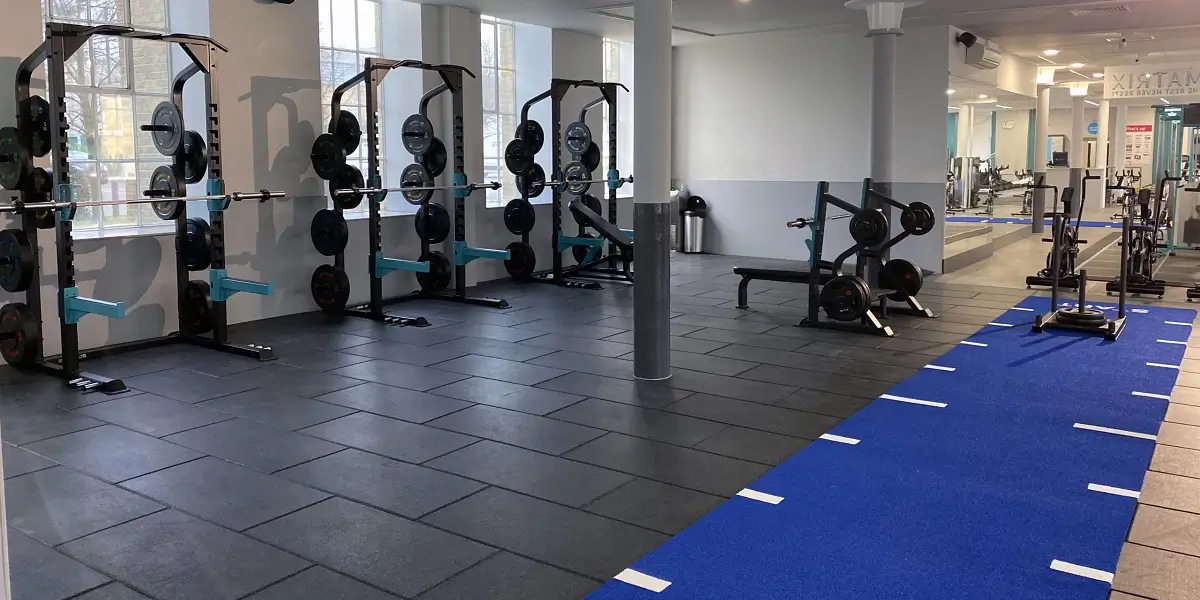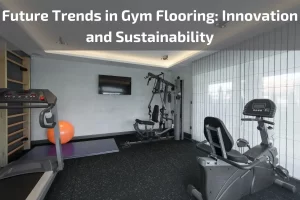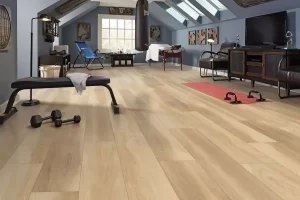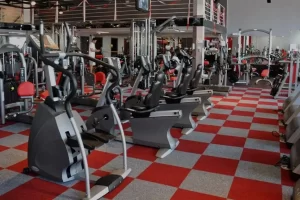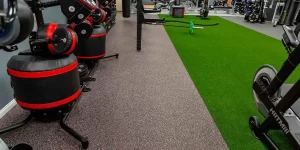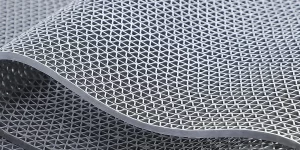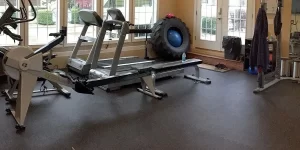As the fitness industry continues to evolve, so too does the technology and innovation behind gym flooring. Today, gym flooring is not only about providing a sturdy surface for exercise; it’s also about embracing sustainability and integrating cutting-edge features that enhance performance and safety.
In this article, we delve into the future trends shaping the world of gym flooring, focusing particularly on innovation and sustainability. From advanced materials to eco-conscious manufacturing processes, the future of gym flooring is filled with exciting developments that promise to revolutionize fitness spaces around the world.
Importance of Gym Flooring in Fitness Facilities
The flooring in fitness facilities serves as the foundation for every exercise, movement, and activity undertaken within the space. Its significance goes beyond merely providing a surface to walk or exercise on; it plays a pivotal role in ensuring safety, performance, and overall user experience. Here’s why gym flooring holds paramount importance in fitness facilities:
- Safety: Gym flooring acts as a cushioning barrier between the user and the hard subfloor, reducing the impact on joints, muscles, and ligaments during high-intensity workouts. It minimizes the risk of injuries such as slips, trips, and falls, creating a safer environment for users of all fitness levels.
- Shock Absorption: During intense workouts, the repetitive impact of movements like jumping, running, and lifting weights can strain the body. High-quality gym flooring with adequate shock absorption properties helps absorb impact forces, protecting the joints and minimizing the risk of stress-related injuries.
- Durability: Fitness facilities experience heavy foot traffic, equipment movement, and dropped weights on a daily basis. Durable gym flooring is essential to withstand the rigors of constant use without wearing down or deteriorating prematurely. It ensures longevity and minimizes the need for frequent repairs or replacements, thereby reducing maintenance costs in the long run.
- Performance Enhancement: The right gym flooring can enhance the performance of athletes and fitness enthusiasts by providing a stable and supportive surface for dynamic movements and exercises. It allows for optimal traction, stability, and balance, enabling users to push their limits and achieve their fitness goals safely and effectively.
- Hygiene and Cleanliness: Gym flooring materials that are resistant to moisture, bacteria, and mold contribute to maintaining a clean and hygienic environment within the fitness facility. Non-porous surfaces are easy to clean and disinfect, preventing the buildup of sweat, dirt, and germs that can harbor odors and pose health risks to users.
- Aesthetic Appeal: Beyond its functional benefits, gym flooring also plays a significant role in enhancing the overall aesthetics and ambiance of the fitness facility. Stylish and visually appealing flooring options can create a positive impression on users, contributing to a welcoming and motivating atmosphere conducive to achieving fitness goals.
- Branding and Identity: Gym flooring can be customized with logos, graphics, and branding elements that reflect the identity and values of the fitness facility. It serves as a powerful branding tool, reinforcing brand recognition and creating a cohesive and professional image that resonates with members and visitors.
Types of Gym Flooring
Choosing the right type of gym flooring is crucial for creating a safe, functional, and attractive workout environment. There are several types of gym flooring materials available, each with its own unique characteristics and suitability for different fitness activities. Here are some common types of gym flooring:
- Rubber Flooring: Rubber flooring is one of the most popular choices for gym facilities due to its durability, shock absorption properties, and versatility. It provides excellent traction, impact resistance, and noise reduction, making it ideal for high-traffic areas, weightlifting zones, and cardio areas. Rubber flooring comes in various thicknesses, textures, and colors to suit different needs and preferences.
- Vinyl Flooring: Vinyl flooring, also known as PVC (polyvinyl chloride) flooring, is a cost-effective option that offers durability, water resistance, and easy maintenance. It provides a smooth and resilient surface for cardio exercises, group fitness classes, and multi-purpose spaces. Vinyl flooring is available in tiles or rolls and comes in a wide range of colors and patterns to complement any gym design.
- Foam Flooring: Foam flooring, often made of EVA (ethylene-vinyl acetate) foam, is lightweight, cushioned, and shock-absorbent, making it suitable for yoga studios, stretching areas, and children’s play zones. Foam tiles are soft underfoot, provide thermal insulation, and offer protection against impact injuries. They are available in interlocking tiles for easy installation and customization.
- Carpet Tiles: Carpet tiles offer a comfortable and plush surface for low-impact exercises, stretching, and floor-based workouts. They provide warmth, sound absorption, and traction, making them ideal for yoga studios, Pilates rooms, and rehabilitation centers. Carpet tiles are easy to install, replace, and maintain, and they come in a variety of colors and textures to complement any gym decor.
- Wood Flooring: Wood flooring, such as hardwood or engineered wood, adds a touch of warmth and elegance to gym spaces. It provides a stable and durable surface for aerobic exercises, dance classes, and functional training areas. Wood flooring offers natural shock absorption and resilience, but it requires regular maintenance to protect against moisture and wear.
- Artificial Turf: Artificial turf is commonly used in functional training areas, outdoor fitness zones, and sports facilities. It mimics the look and feel of natural grass while offering durability, traction, and weather resistance. Artificial turf provides a safe and comfortable surface for agility drills, sled pushes, and outdoor workouts, with minimal maintenance requirements.
- Composite Flooring: Composite flooring combines different materials such as rubber, vinyl, and foam to create a multi-functional surface suitable for various fitness activities. Composite flooring offers the benefits of durability, shock absorption, and customization options, making it a versatile choice for gym owners looking to accommodate diverse workout needs.
Benefits of Quality Gym Flooring
Quality gym flooring is essential for creating a safe, comfortable, and functional workout environment. Here are some key benefits of investing in high-quality gym flooring:
- Safety: Quality gym flooring provides a stable and supportive surface that helps reduce the risk of slips, trips, and falls during workouts. Its shock-absorbing properties minimize the impact on joints and muscles, preventing injuries and promoting safe exercise practices for users of all fitness levels.
- Durability: High-quality gym flooring is designed to withstand the rigors of constant use and heavy foot traffic without wearing down or deteriorating prematurely. It is resistant to damage from dropped weights, equipment movement, and abrasion, ensuring long-term durability and performance.
- Shock Absorption: Quality gym flooring absorbs impact forces generated during high-intensity workouts, protecting the body from excessive stress and strain. It helps reduce the risk of stress-related injuries such as joint pain, muscle soreness, and fatigue, allowing users to exercise comfortably and safely.
- Noise Reduction: Gym flooring with sound-absorbing properties helps minimize noise levels within the fitness facility, creating a more pleasant and conducive workout environment. It reduces the transmission of impact noise from dropped weights and equipment, promoting a quieter and more enjoyable exercise experience for users and neighboring spaces.
- Easy Maintenance: High-quality gym flooring is designed for easy cleaning and maintenance, requiring minimal effort to keep it looking clean and fresh. Its non-porous surface resists stains, odors, and moisture, making it easy to wipe down and sanitize between workouts. Low-maintenance flooring saves time and effort for gym staff, allowing them to focus on providing quality service to members.
- Customization Options: Quality gym flooring comes in a variety of colors, textures, and patterns, allowing for customization and personalization to match the design aesthetic and branding of the fitness facility. Custom logos, graphics, and markings can be incorporated into the flooring to enhance the visual appeal and identity of the space.
- Hygiene and Cleanliness: Quality gym flooring materials are resistant to bacteria, mold, and mildew growth, promoting a clean and hygienic workout environment. Antimicrobial properties inhibit the spread of germs and pathogens, reducing the risk of infections and illnesses among gym users. Cleanliness and hygiene are essential for maintaining a healthy and safe fitness facility.
- Enhanced Performance: Quality gym flooring enhances the performance of athletes and fitness enthusiasts by providing a stable and supportive surface for dynamic movements and exercises. It offers optimal traction, stability, and shock absorption, allowing users to perform at their best and achieve their fitness goals safely and effectively.
Importance of Choosing the Right Gym Flooring
Selecting the appropriate gym flooring is a critical decision for fitness facility owners and managers. The choice of flooring material can significantly impact the safety, functionality, and overall experience of gym users. Here’s why choosing the right gym flooring is of paramount importance:
- Safety of Gym Users: The safety of gym users is paramount, and the right flooring choice plays a crucial role in ensuring their well-being. Proper gym flooring provides traction and stability, reducing the risk of slips, falls, and injuries during workouts. Choosing flooring with adequate shock absorption properties helps minimize the impact on joints and muscles, promoting safe exercise practices.
- Protection of Equipment: Gym equipment is a significant investment, and the flooring beneath it should offer protection against damage caused by impact and weight. Quality gym flooring absorbs shock and minimizes vibrations, safeguarding equipment from premature wear and tear. This extends the lifespan of gym equipment and reduces maintenance costs over time.
- Versatility for Different Activities: Fitness facilities host a variety of activities and workouts, from cardio exercises to weightlifting and functional training. The right gym flooring should be versatile enough to accommodate different types of exercises and equipment without compromising performance or safety. Selecting flooring materials that offer sufficient traction, support, and durability ensures optimal conditions for various fitness activities.
- Durability and Longevity: Gym flooring undergoes constant use and abuse, from heavy foot traffic to dropped weights and equipment movement. Choosing durable flooring materials that can withstand the rigors of daily wear and tear is essential for maintaining the integrity and aesthetics of the fitness facility. Quality gym flooring is designed to withstand high-impact activities and heavy loads, ensuring long-term durability and performance.
- Aesthetic Appeal and Branding: The appearance of the gym space plays a significant role in attracting and retaining members. The right gym flooring contributes to the overall aesthetic appeal of the facility, creating a visually appealing and inviting environment for users. Additionally, gym flooring can be customized with logos, colors, and branding elements to reinforce the identity and values of the fitness brand.
- Hygiene and Maintenance: Cleanliness and hygiene are critical considerations in any fitness facility. Gym flooring should be easy to clean, sanitize, and maintain to ensure a hygienic workout environment. Choosing non-porous flooring materials that resist moisture, stains, and bacterial growth simplifies the cleaning process and reduces the risk of odors and contaminants.
- Regulatory Compliance and Standards: Compliance with industry standards and regulations is essential for ensuring the safety and legality of the fitness facility. The right gym flooring should meet relevant safety, fire, and environmental regulations to protect the well-being of users and adhere to legal requirements.
Maintaining and Cleaning Your Gym Flooring
Proper maintenance and regular cleaning are essential for preserving the appearance, functionality, and longevity of gym flooring. Here are some important tips and techniques for maintaining and cleaning your gym flooring:
- Establish a Routine Cleaning Schedule: Develop a regular cleaning schedule to keep your gym flooring looking its best. Depending on the traffic and usage levels, consider daily, weekly, and monthly cleaning routines to remove dirt, debris, and sweat buildup.
- Sweep or Vacuum Regularly: Use a soft-bristle broom or a vacuum cleaner with a brush attachment to sweep or vacuum the gym flooring regularly. This helps remove loose dirt, dust, and debris that can accumulate over time and scratch the surface of the flooring.
- Spot Clean Spills and Stains Immediately: Promptly clean up spills, stains, and marks on the gym flooring to prevent them from setting and becoming more difficult to remove. Use a damp cloth or mop with mild detergent to spot clean the affected areas, then rinse thoroughly with clean water.
- Use Recommended Cleaning Products: Refer to the manufacturer’s guidelines and recommendations for cleaning products that are safe and suitable for your specific type of gym flooring. Avoid harsh chemicals, abrasive cleaners, or ammonia-based products that can damage or discolor the flooring material.
- Mop with a Mild Detergent Solution: For routine cleaning, use a mop with a mild detergent solution and warm water to wash the gym flooring. Avoid using excessive water, as standing water can seep into the seams and edges of the flooring, causing damage and promoting mold growth.
- Use Non-abrasive Cleaning Tools: Avoid using abrasive cleaning tools such as steel wool pads or abrasive scrub brushes, as they can scratch or damage the surface of the gym flooring. Opt for soft cloths, sponges, or non-abrasive scrubbing pads for gentle cleaning and maintenance.
- Invest in Floor Cleaning Equipment: Consider investing in floor cleaning equipment such as auto-scrubbers or floor buffers for large gym facilities. These machines can help streamline the cleaning process and ensure thorough cleaning and sanitation of the flooring surface.
- Dry the Flooring Surface Thoroughly: After mopping or cleaning the gym flooring, use dry towels or a mop to remove excess moisture and dry the surface thoroughly. Proper drying helps prevent water damage, mold growth, and slip hazards, maintaining a safe and hygienic workout environment.
- Inspect and Repair Damage Promptly: Regularly inspect the gym flooring for signs of wear, damage, or deterioration, such as scratches, cracks, or discoloration. Address any issues promptly by repairing or replacing damaged tiles or sections to prevent further damage and maintain the integrity of the flooring system.
- Consult Professional Cleaning Services: For deep cleaning and maintenance tasks, consider hiring professional cleaning services specializing in gym flooring. Professional cleaners have the expertise, equipment, and techniques to effectively remove embedded dirt, stains, and contaminants, revitalizing the appearance and performance of your gym flooring.
Conclusion
In conclusion, maintaining and cleaning your gym flooring is essential for preserving its appearance, functionality, and longevity. By establishing a routine cleaning schedule, using recommended cleaning products and techniques, and addressing issues promptly, you can ensure that your gym flooring remains safe, hygienic, and attractive for users.

